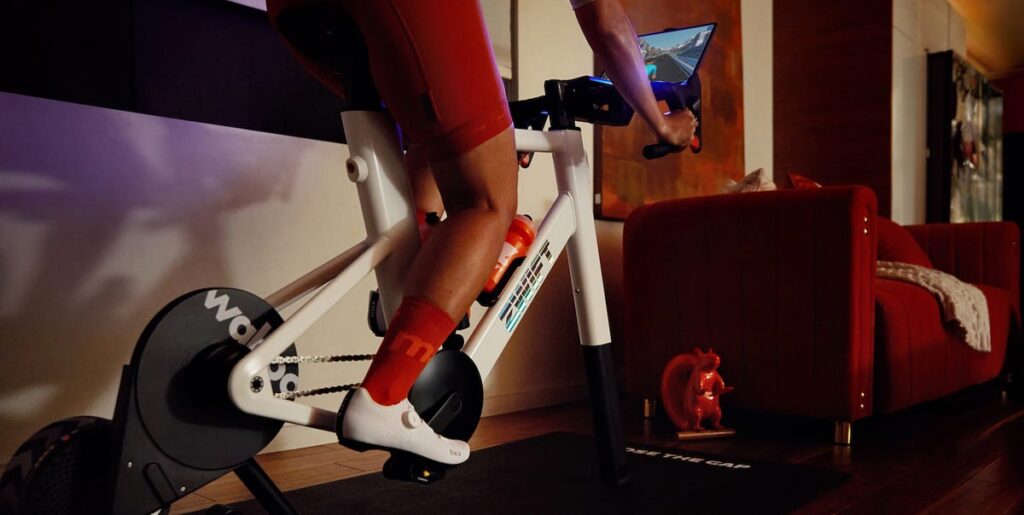I’m passionate about many things: my family, my dog, my morning cup of cold brew, my triathlons, and my road bike. I’m less than enthused, however, about cycling in dreary weather conditions, which in the New York City winter months can mean wet roads, stinging sleet, and heavy snow. Sure, there are alternatives: group cycling classes, signing up for warm-weather destination races, braving the negative windchill—but all I really want is an at-home cycling setup that’s easy to install and fun to ride.
So when I was offered an opportunity to try out the Zwift Ride—an indoor-cycling trainer that pairs with the Zwift virtual-cycling app via Bluetooth—I jumped at the opportunity. Zwift gets big props from cyclists of all stripes for how closely the technology mimics IRL rides, so I was eager to get on board and give it a spin. Here’s what I learned after a couple of weeks in the stationary saddle.
Lesson 1: It’s Way Easier to Bring Home Than I Thought
Generally speaking, I’m terrible at setting things up. It once took me over a week to figure out how to put together a dining room chair … that only had two parts! So I admit I was a bit apprehensive when the Zwift Ride landed on my doorstep. But the instructional setup videos were so easy to follow that I had my riding station assembled on my training mat in just a few minutes. All that was left to do was download the Zwift app on my phone, and then pair it with the smart trainer via Bluetooth.
With my phone secure in the handlebar tablet holder, I was off to the races. This first takeaway ended up being as important as any: Zwift Ride was so much easier to set up, install, and get riding on than I anticipated. And at a $1,300 price point, it’s more affordable than many other smart bikes. Same goes for the Zwift app, which has a $200 annual membership plan. The Zwift Ride and annual plan together comes out to just about $5 per day—not much more than a cup of coffee! For those prioritizing flexibility, there’s also a monthly plan that’s $20 per month.
Lesson 2: The Real World and Virtual World Work Together
I quickly found myself exploring Watopia, one of the most popular virtual courses in the Zwift app. These are animated maps that you ride around as a 3D avatar alongside other cyclists from around the (real) world. It’s such an immersive experience—and Zwift is also compatible with smart TVs, tablets, and laptops, which have larger screens that add to the feeling of really being there. As I cruised around, my Zwift Ride would emulate whatever terrain I was seeing on my screen. For example, when the virtual roads were steep, my real-world trainer provided more resistance, so it felt like I was really climbing uphill. This kept me engaged with my ride, ensuring I was always physically challenged in a productive way.
Lesson 3: It’s Great for Multifaceted Training
As a triathlete, I aim for a blend of training methods. Zwift has workouts that helped my endurance training, including high-intensity intervals, power and endurance rides, and VO2-max builders. It also has plenty of cycling-specific workouts, such as sprints, climbs, and recovery rides. And you don’t need to do these alone: Many of the Zwift workouts are written by professional cyclists who give encouragement and tips along the way. With over 2,000 available workouts, I could always find a way to fit Zwift into my day. For example, on particularly busy days, I signed up for short interval rides. Whenever I had more time, I’d do longer endurance-focused rides.
Lesson 4: I’m Kinda Competitive? (Maybe I Already Knew That…)
I don’t like to fall behind when I ride in the park with my cycling buddies in NYC, but I tend to give riders who pass me a nod and stick to my own pace when I’m riding solo. However, seeing my avatar get passed in Watopia awakened my competitive side! When the app urged me to “close the gap,” I couldn’t help but push myself to make up the distance—or at least do my best to not fall farther behind. And yet the app always felt in tune with my honest ability—these messages were motivational without encouraging me to exert myself too hard.
Lesson 5: There’s a World of Community
As I rode around Watopia, I encountered cyclists with so many different national flags above their avatars. This made me realize how big the Zwift community is. And it’s not like everyone’s just on their own siloed rides—it’s a truly social experience if you want it to be. The Zwift companion app makes it easy to connect with friends, join group rides, join clubs, and find friends on Zwift. And to make races fair and competitive, their new Racing Score system calculates your performance to match you with other cyclists who you’ll keep pace with. Knowing that I could always join a group ride, no matter how isolating the weather outside of my home might feel, was comforting.
Final Takeaways
I was always so glad to have Zwift as an option when the weather outside was bleak, or I just wasn’t up for an outdoors ride at the end of a long workday. With 12 different virtual worlds, 120 different routes, and over 2,000 workouts—plus additional training plans, racing, fitness tracking, and group ride options—there was always something new to keep me engaged. The best part, though, was that I never felt like I was short-changing my training or phoning it in. The Zwift rides were just as challenging as real-world cycling, with one huge bonus: I never had to change a flat.
Use the code MHZWIFT10 at Zwift.com/shop for a 10% discount on the Zwift Ride and Wahoo KICKR CORE smart trainers with or without bundled membership. Valid until March 31st, 2025.
Read the full article here



